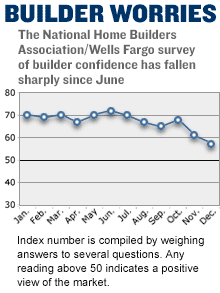 |
 |
| 1. |
|
| 2. |
|
| 3. |
|
| 4. |
|
|
|
|
|
|
|
|
|
NEW YORK (CNNMoney.com) -
The obituary for this decade's housing boom has been written many times in recent months, but the market continues to shrug off reports of its demise and show continued strength.
Certainly many numbers have spelled doom. Just this week the National Association of Home Builders/Well Fargo Housing Market Index, which measures builder confidence, posted another decline to fall 20 percent below its high for the year in June.
In addition a forecast for the nation's 100 largest markets done by Economy.com and home property-valuation service Fiserv CSW for Fortune magazine found tougher times ahead in many markets, with 16 percent of markets expected to see home values decline in 2006, and nearly 30 percent to lose ground over the next two years. Overall home values are forecast as posting a modest 7 percent gain in prices in 2006 and flat prices in 2007.
And to pile on, a week ago home builder Toll Brothers (Research) warned it would have trouble meeting 2006 earnings forecasts and said it appeared that home demand would slow next year to pre-boom levels.
But then comes Tuesday's housing start and building permit figures for November from the Census Bureau. They bounced back from a weak October to easily top forecasts. Both readings, in fact, were the fourth best on record. And the number of single-family home starts matched a February record.
David Seiders, chief economist with the NAHB, said it's too soon to say that housing is out of the woods based on Tuesday's report, but it's probably too early to say it's definitely reached its peak.
"The thing we're trying to figure out is are we close to or are we past the tipping point. So far the jury is out," he said.
The NAHB is forecasting a slight decline in building in 2006, but Seiders said it is possible the market could surprise to the upside once again, especially if mortgage rates don't climb another half-percentage point as the trade group forecasts.
Others say that the latest report of a building rush shouldn't be mistaken for the housing market showing continued gains.
"It could be that home builders are trying to work off the supply of permitted properties they have in the pipeline," said Orawin Velz, economist with the Mortgage Bankers Association. "If you look at leading indicators of the housing market, you really have to say this cannot be sustained."
Softness in pricing
Seiders said it's clear from talking to builders that rising interest rates are putting a crimp in demand for housing. That means builders are having to edge down the bumpy road traveled by the nations' automakers ... using incentives to keep sales strong.
"There are some price reductions going on in the new home market," he said. "More commonly it is the non-price incentives, giving away some amenities, paying closing costs."
Of course home builders aren't like the automakers trapped by high fixed costs and union contracts that make cutting staff difficult. If the housing market does cool significantly, there could be the loss of 500,000 construction jobs in the next two years according to the UCLA Anderson Forecast. Another 300,000 jobs could be lost in the finance sector.
The importance of housing in powering the U.S. economy is one reason that some many economists have been keeping such a close eye on the strength of the market. But so far they've been wrong every time they've projected a slowdown ahead in recent years.
"Last year all the forecasting was underestimating what the market would do," said Pam O'Connor, CEO of Leading Real Estate Companies of the World, the nation's largest network of independent residential real estate firms. "Most people in our business would say we're past the peak, but that's still tempered by a lot of demand out there. You've still got a lot of baby boomers buying and trading up."
The Census Bureau figures show the supply of new homes on the market rising 20 percent over the last year, and increasing or staying level every month during that period. But Seiders said that some of that growth is in homes permitted but not started, which are counted as new homes for sales in the report. Homes completed but not yet sold have stayed relatively steady, he said.
O'Connor and others say that the building rush in the latest report doesn't necessarily suggest there will be a glut of new homes on the market driving down prices.
"While there has clearly been a cooling in the marketplace, I attribute this to a return to economic equilibrium in the real estate market," said Manhattan real estate lawyer Neil Garfinkel. "This is the marketplace which we are returning to and it's a positive."
For a closer look at the housing starts report, click here.
For a closer look at the real estate market and what it means to you and the economy, click here.

|